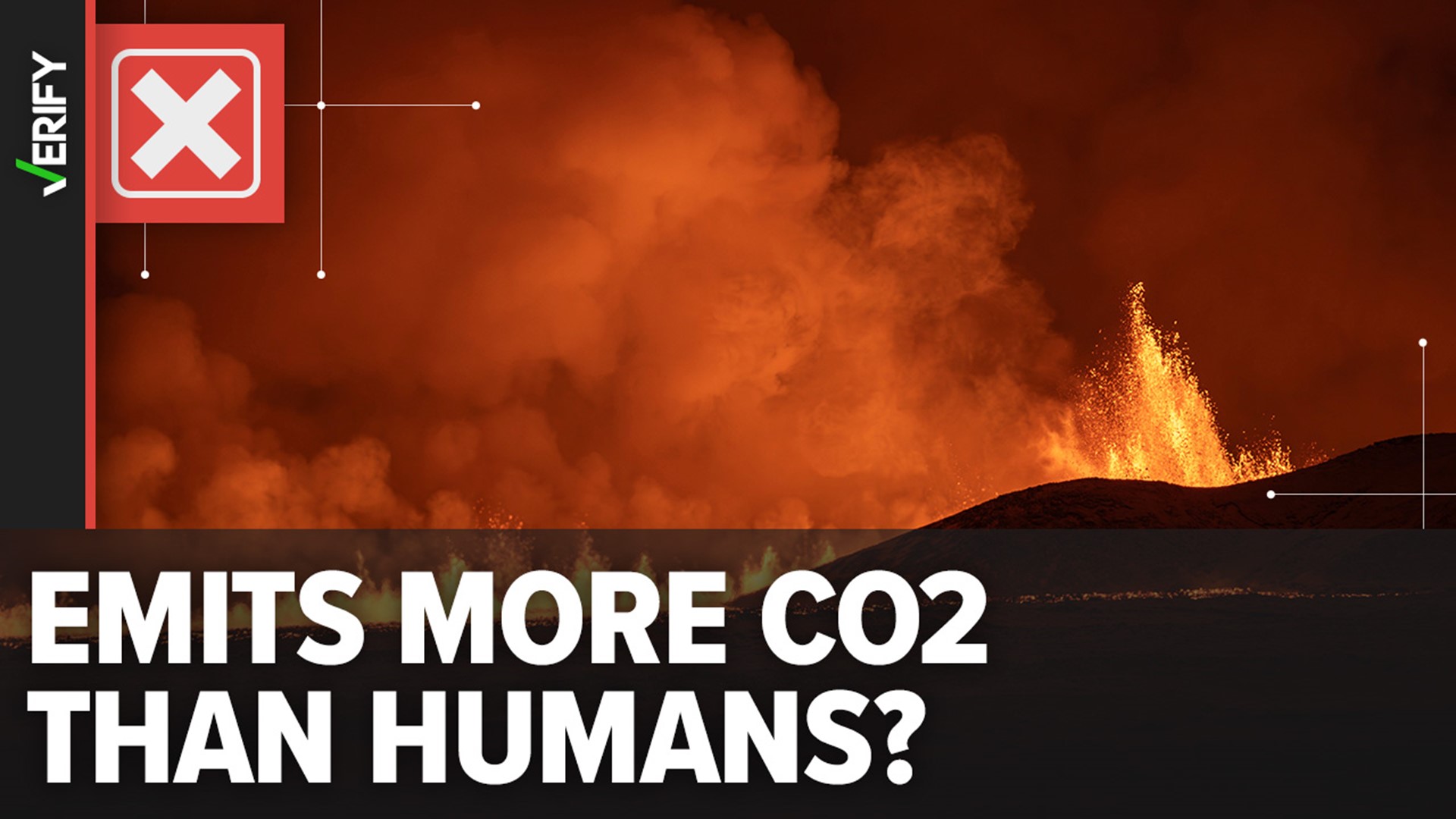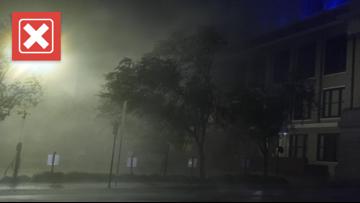Editor's note: A volcano on the Reykjanes peninsula began erupting on Dec. 18. This story has been updated to reflect the ongoing eruption.
A volcano beneath Iceland’s Reykjanes peninsula erupted Dec. 18. This eruption followed an increase in earthquake activity that began in late October and at some points rocked the region with more than 1,000 earthquakes each day, according to the Icelandic Meteorological Office.
A post on X, viewed over 5 million times, claimed prior to the volcano’s eruption it would emit more carbon dioxide into the atmosphere “than all humans put together” when it erupted. This claim was echoed in other viral posts then and people have made similar claims comparing volcanoes to human CO2 emissions since the eruption began.
Carbon dioxide is the most abundant greenhouse gas released into the atmosphere by human activities such as burning fossil fuels, and is thus a significant contributor to climate change.
THE QUESTION
Is the erupting Reykjanes volcano emitting more carbon “than all humans put together?”
THE SOURCES
- National Oceanic and Atmospheric Administration (NOAA)
- United States Geological Survey (USGS) scientist Terry Gerlach
- International Energy Agency (IEA)
- Smithsonian Institution's Global Volcanism Program (GVP)
- Catalogue of Icelandic Volcanoes
- Research from the University of Iceland’s Institute of Earth Sciences
- Deep Carbon, a geoscience textbook focused on carbon beneath Earth’s surface
THE ANSWER
No, the erupting Reykjanes volcano is not emitting more carbon “than all humans put together.”
WHAT WE FOUND
The Reykjanes volcano in Iceland has never erupted with enough power to emit carbon at the same rate as humanity’s emissions. For context, all of the volcanoes combined do not emit as much carbon dioxide as humans do.
“Human activities emit 60 or more times the amount of carbon dioxide released by volcanoes each year,” the National Oceanic and Atmospheric Administration (NOAA) says.
“Large, violent eruptions” can emit carbon dioxide at high enough rates to match humanity’s emissions for the few hours that they last, NOAA says. But these types of eruptions are “too rare and fleeting to rival humanity’s annual emissions.”
To understand why the eruption of the Reykjanes volcano isn’t comparable to those rare, intense eruptions, you first have to understand that there are two different types of volcanic eruptions. Explosive eruptions are the more violent and intense type of eruptions, and mainly produce ash, pumice and debris, according to the USGS. Effusive eruptions are comparatively gentle, the British Geological Survey says, and primarily produce slow-moving lava flows.
The current eruption is an effusive eruption. This livestream of the eruption shows that it’s emitting lava fountains and producing lava flows. The Icelandic Meteorological Office says the eruption is focused on five vents producing lava fountains and lava flows.
Effusive eruptions usually happen continuously over long periods of time, and therefore gradually emit carbon dioxide over the course of the eruption rather than all at once. A volcano can emit a lot of carbon during an effusive eruption; the eruption that emitted the most carbon dioxide between 2005 and 2018 was the 2014 Holuhraun effusive eruption in Iceland, according to researchers behind a textbook called Deep Carbon, which focuses on carbon beneath the Earth’s surface.
Deep Carbon estimated Holuhraun emitted over 9 million tons of carbon dioxide during its eruption. The eruption lasted almost six months, according to Business Iceland, a public-private partnership to promote Icelandic business.
NASA says humanity emitted 35 billion tons of carbon dioxide in 2014. So over those same six months, humans would have released 17.5 billion tons of carbon dioxide into the atmosphere. That’s almost 2,000 times the carbon Holuhraun emitted.
The Reykjanes volcanic system is next to the Fagradalsfjall volcano, a similar volcano that has had three effusive eruptions since 2021, the most recent of which ended August 2023, the GVP says.
Research from the University of Iceland’s Institute of Earth Sciences estimated the 2023 Fagradalsfjall eruption emitted between 7,000 and 15,000 tons of carbon dioxide each day it was erupting. In contrast, the 2014 Holuhraun eruption emitted 51,258 tons of carbon dioxide each day.
The Reykjanes eruption likely falls somewhere in between the Fagradalsfjall and Holuhraun eruptions in its carbon emissions.
Humans emitted at least 36.8 billion tons of carbon dioxide in 2022, the International Energy Agency (IEA), an organization that provides data and policy recommendations to its few dozen member countries, said in its most recent carbon dioxide emissions report.
Based on the amount of carbon dioxide humans emitted in 2022, human activities release just over 100 million tons of carbon into the atmosphere each day, and about 70,000 tons every minute.
Many countries emit more carbon than the Holuhraun eruption did each day. Ethiopia, which ranked 91st among carbon emissions by country in 2022, emits just over 52,000 tons of carbon dioxide each day, according to the Global Carbon Atlas.
Explosive eruptions
While this was an effusive eruption, the Reykjanes volcano can sometimes produce explosive eruptions depending on which part of the volcano erupts, according to the Catalogue of Icelandic Volcanoes.
But Reykjanes has never had a “large, violent” eruption capable of matching those emission rates.
United States Geological Survey (USGS) scientist Terry Gerlach estimated in a 2011 paper that the explosive 1980 Mount St. Helens eruption released as much carbon over the course of its eruption as humanity emits every 2.5 hours, while the explosive 1991 Mount Pinatubo eruption released the same amount of carbon as humanity does in 12.5 hours.
Both volcanoes erupted over a period of nine hours, Gerlach said. So Mount St. Helens emitted carbon at an hourly rate just under the rate of humanity’s emissions, while Mount Pinatubo emitted slightly more carbon per hour than humans do.
The 1980 Mount St. Helens and the 1991 Mount Pinatubo eruptions were rated a 5 and 6 respectively on the Volcanic Explosivity Index (VEI), which is a scale running from 0 to 8 designed to rate the intensity of a volcanic eruption. Eruptions on this scale are rare; there have only been six eruptions rated VEI 5 and one eruption rated VEI 6 since 1960, according to the Smithsonian Institution's Global Volcanism Program (GVP).
The part of the Reykjanes volcanic system that can erupt explosively typically erupts at an intensity between VEI 1 and VEI 3, the Catalogue of Icelandic Volcanoes says.
Some studies have estimated that all of the world’s volcanoes emit as much as 600 million tons of carbon dioxide in an average year, NOAA says. Again, that’s 60 times less than humanity’s 36 billion tons of carbon emissions.
And Reykjanes is just one of hundreds of volcanoes around the globe.












